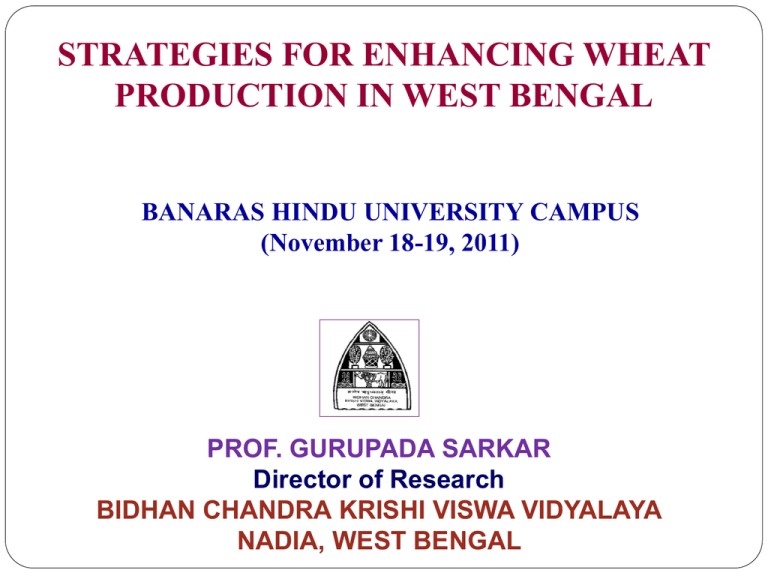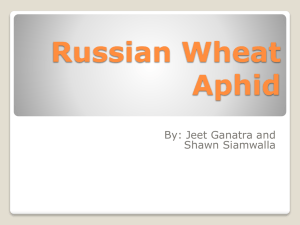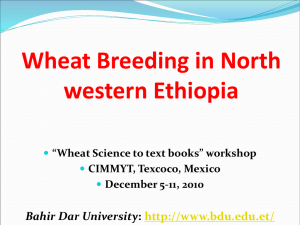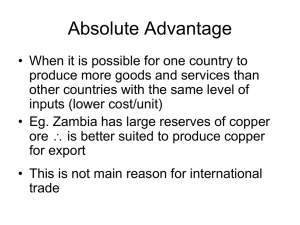BIDHAN CHANDRA , Krishi Vishwavidyalaya
advertisement

STRATEGIES FOR ENHANCING WHEAT PRODUCTION IN WEST BENGAL BANARAS HINDU UNIVERSITY CAMPUS (November 18-19, 2011) PROF. GURUPADA SARKAR Director of Research BIDHAN CHANDRA KRISHI VISWA VIDYALAYA NADIA, WEST BENGAL Hill Zone 3% UBKV Terai Zone 14% Old Alluvial Zone 20% 22057’ L, 880 20’E; 9.75 m msl New Alluvial Zone 22% BCKV Red and Laterite Zone 27% Coastal and saline Zone 14% AGROCLIMATIC ZONES OF WEST BENGAL Wheat scenario of West Bengal Wheat area : 3. 17 lakh ha (India 28.5 m ha) Production : 8.42 lakh tonne (India 85.9 mt) Productivity : 2658 kg (India 2900 kg/ha) Wheat occupies food grain area of the state: 6.0 % Contribution to state’s food grain production: 5.06 % Contribution to national wheat production: below 1.0% Wheat Production Scenario in West Bengal Year Wheat Area Prodn. Yield (Th. ha) (Th. t) (kg/ha) 2000-01 380.0 950.0 2500 2001-02 2002-03 2003-04 2004-05 2005-06 434.0 405.0 425.7 400.1 366.7 961.5 875.0 985.7 841.7 773.5 2215 2159 2315 2103 2109 2006-07 2007-08 350.6 352.6 799.9 917.3 2282 2602 2008-09 307.0 764.5 2490 2009-10 315.9 837.0 2650 2010-11 316.8 842.0 2658 3000 2500 2000 1500 1000 500 0 Area (`000 ha) Production. (`000 tonnes) Yield (kg /ha) West Bengal is not a major wheat producing state in India Its contribution to national wheat production is negligible, and to state’s food production is also not very significant Which requires attention from the planners and policy makers to increase the area and production of wheat for food and nutritional security of the state and the country as well. The major constraints limiting the yield of wheat are: Late sowing because of excessive soil moisture after rice harvest Shorter wheat growing season because of short span of winter leading to incidence of high temperature during flowering and grain maturity Low mechanization Imbalanced nutrient use Poor land leveling Rain and storm during maturity, Severe pest s(white ants, rats and birds) and diseases (especially foliar blight) infestation Major irrigated areas of the state are occupied by vegetables, potato, rice and high value crops WHEAT YIELD UNDER CHANGING CLIMATIC CONTION 50.0 45.0 y = -0.4973x + 37.484 R² = 0.0952 40.0 35.0 30.0 25.0 Temp Avg 20.0 y = -0.4966x + 30.349 R² = 0.0659 15.0 y = 0.1123x + 21.238 R² = 0.2272 10.0 Yield Normal Yield Late Linear (Temp Avg) 5.0 0.0 0 1 2 3 4 5 6 7 8 9 10 11 The above graph depicts an increasing temperature and simultaneously decreasing yield trends over the years from 1995 onwards. Return from different crop during winter season Crop Cost of cultivation (Rs./ha) Gross return (Rs./ha) Net return B:C ratio (Rs./ha) Wheat 23000 30000 7000 0.30 Boro paddy 27000 45000 18000 0.67 Potato 74000 95800 82000 120000 293000 215000 46000 197200 133000 0.62 2.06 1.63 Brinjal Tomato In West Bengal, the major wheat growing districts are: Murshidabad, Nadia, Malda, Uttar (North) Dinajpur, Jalpaiguri, Coochbehar and Birbhum. These districts contribute about 87% production from 88% wheat area in the State The non-traditional wheat growing districts of the state can be covered under wheat crop are: Wheat area in Bankura, 24-Parganas (North), Burdwan, Dakshin (South) Dinajpur and Midnapur (West) districts of the state can be increased under wheat crop. Climatic potential and district average yields and yield gaps in non-traditional districts of West Bengal District Potential yield (t/ha) Farmers’ yield (t/ha) Yield gap (%) Burdwan 5.0 2.6 48 Midnapur (W) Dinajpur (S) 4.9 2.3 53 6.4 2.3 64 Bankura 24 pgs (N) 5.3 2.3 57 4.8 2.3 52 What can be done for introduction of wheat crop in the non-traditional areas of the state? 1. Increasing awareness among the farmers regarding cultivation of grain crops in general and wheat in particular because of less requirement of irrigation water as compared to boro rice 2. Availability of high yielding wheat varieties to be ensured for timely, late and rainfed cultivation 3. Adoption of conservation agriculture can be helpful in addressing the delayed sowing of wheat 4. Implements of conservation agriculture should be made available 5. Salinity tolerant wheat cultivars should be introduced in the saline zone Policy matters Introduction of high yielding varieties with replacement of low potential and pest and disease susceptible varieties. Increase of area under wheat with the reduction in boro(summer) rice area in the state Encouragement for timely sowing for proper growth and increase productivity Balanced use of plant nutrients along with the use of micronutrients as per soil test reports. Addition of organic matter to soil through green manuring and crop residue recycling, balanced fertilization, integrated nutrient management, diversification/intensification of rice-wheat system by including pulse crops are some of the possible remedial measures to improve soil productivity and hence, total factor productivity. Contd….. Organizing large scale on farm trials and demonstrations on newly released varieties and RCTs to generate acquaintance and confidence amongst the farmers. Organizing farmers training programmes to educate the farmers regarding newly released varieties and up to date knowledge of POPs Production of quality seeds in university and state farms Creation of infrastructural facilities for storage of quality seeds Developing market facilities for disposal of wheat at a remunerative price. SEED PRODUCTION PROGRAMME The centre used to multiply (8-10 q) seeds of some important varieties of the region every year (e.g. PBW 343, HD 2733, K 0307) and hand over the seeds (as TL Seed) to the Directorate of Farms of the University to supply it to the wheat growers through KVKs. Currently Mega Seed project of the university has taken up wheat seed production programme In West Bengal wheat seed produced 92.74 and 89.20 t in 2007-08 and 2008-09, respectively Research findings/Technologies developed Performance of genotypes under Rainfed condition Sl. No. Entries HUW 609 Days to Test maturity weight (g) 116 42.5 Max. Yield (q/ha) 28.3 1. 2. PBW 612 110 42.0 23.9 3. K 0616 111 43.0 23.0 4. C 306 120 38.0 24.3 5. MACS 6145 112 43.5 22.6 6. HD 2888 110 44.0 22.0 7. HD 3070 117 34.0 21.3 PERFORMANCE OF WHEAT GENOTYPES UNDER IRRIGATED TIMELY SOWN CONDITION WHEAT ENTRIES K 9107 DBW 39 HD 2997 HD 2967 HUW 612 TIMELY SOWN WHEAT TIMELY (19- 25 NOV.) ENTRIES SOWN (19- 25 NOV.) (YIELD q/ha) (YIELD q/ha) 35.3 K 0307 34.4 36.9 PBW 343 34.2 34.2 DBW 54 36.4 34.0 HD 2733 35.4 34.0 CBW 38 34.2 Range of yield : 34.0 to 36.5 q/ha PERFORMANCE OF WHEAT GENOTYPES AT LATE AND VERY LATE SOWING UNDER IRRIGATED CONDITION WHEAT ENTRIES WH 1022 DBW 51 Raj 4101 HI 1563 NW 4035 HD 2985 LATE SOWN (17-23 DEC) (Yield q/ha) 31.1 28.8 28.9 28.4 27.6 26.2 (Av. 28.9) WHEAT ENTRIES HD 2985 PBW 579 WH 1046 HI 1563 NW 4035 DBW 51 V. LATE SOWN (1-7 JAN) (yield q/ha) 22.9 22.1 20.2 21.7 21.1 19.5 (Av. 21.4) 26% HW 2045, DBW 14, PBW 343, HUW 234, NW 2036 Management of rice residues in rice-wheat system (2006-2009) Treatments Grain yield of Grain yield wheat (qha-1) of rice (qha-1) WEY (qha-1) T1: DSR (removal)- Wheat 33.9 30.8 60.11 T2: DSR (straw incorporation)-W 32.2 54.41 T3: T2 + 25% N more )- Wheat 27.1 34.7 34.0 63.63 T4: DSR (Burning)- Wheat 32.3 35.1 62.16 T5: DSR (surface retention + 25% N more) Wheat 33.1 37.1 64.66 T6: DSR (surface retention + Sesbania)- Wheat 25.3 37.3 56.97 T7: DSR (surface retention)- Wheat (No fertilizer) 12.6 22.1 31.39 T8: DSR (removal)- Wheat (No fertilizer) 13.8 20.5 31.20 T9: Transplanted rice (removal) 31.9 3.53 37.7 63.95 3.24 5.53 C.D. at 5% Grain yield of timely sown wheat genotypes (q ha-1) at different irrigation schedules Wheat genotypes HD 2997 DBW 46 RSP 561 HD 2733 (c) PBW 343 (c) K 0307 (c) HD 2967 (I) DBW 39 (I) Mean One 27.4 24.6 23.0 23.4 25.6 22.5 22.3 23.6 24.1 Number of irrigations Rank Three Rank Five 31.2 33.6 1 1 26.4 30.4 3 7 29.2 31.8 6 4 29.6 34.6 5 3 30.4 35.4 2 2 24.4 29.0 7 8 28.4 32.8 8 5 27.8 32.4 4 6 28.4 18% 32.5 Rank 3 7 6 2 1 8 4 5 35% I1 - at CRI (20-25 DAS) I2 - at CRI, Tillering (40-45 DAS) and Boot leaf stage (75-80DAS) I3 - at CRI, Tillering, Jointing (60-65 DAS), Boot leaf and Milk stages Grain yield of wheat genotypes (q ha-1) under different dates of normal sowing Wheat varieties HD 2733 PBW 343 K0307 DBW 39 Mean Yield (q/ha) Mean D1 (11.11.10) D2 D3 (18.11.10) (25.11.10) 34.5 35.5 32.8 32.4 33.8 34.5 39.7 34.6 34.4 35.8 34.5 36.8 33.4 33.0 34.4 34.5 37.3 33.6 33.3 The extent of reduction in grain yield was 13.33 and 27.33 kg/ha/day for a delay of 15 and 30 days from 18th November sown crop KRL 19, KRL 210, KRL 213 were found to be best salt tolerant high yielding wheat cultivars at Sundarbans Closer spacing (17.5-20.0 cm) was found be better than previously followed 22.5 cm spacing in respect of grain yield It was observed that 128 mm of water can be saved if wheat crop is irrigated with 2cm at 22 DAS, 4cm at 66 DAS and 4cm at 80 DAS as compared to irrigation at all stages (22, 46, 66 and 80 DAS) at 5 cm depth of water without sacrificing yield Correlation Coefficient between Leaf Blight Severity (Y) and Different Weather Parameters Weather 20062007-08 2008-09 2009-10 2010-11 parameters 07 Temp. Max 0.69 0.70 0.995** 0.99** 0.97* (X1) Temp. Min 0.86 0.97* 0.98 0.94 0.98* (X2) RH Max (X3) -0.65 -0.68 -0.74 -0.92 -0.61 RH Min (X4) -0.61 -0.51 -0.92 -0.53 -0.67 Rainfall (X5) Sunshine hours (X6) 0.41 -0.68 - 0.35 0.32 0.42 0.69 -0.42 0.23 0.54 * Significant at 5% level; **Significant at 1% level Y = -280.86 + 37.54X1 - 2.15X2 - 0.58X3 - 77.95X6 [R2 = 1.000; R2adj. 1.000] 28 Effect of AUDPC OF leafblight Disease on 160.00 Yield (2006-07 to 2010-11) Yield AUDPC 140.00 27 100.00 25 80.00 60.00 24 40.00 23 20.00 22 0.00 2006-07 2007-08 2008-09 2009-10 1010-11 Year Relationship between yield and leaf blight disease severity (2006-07 to 2010-11) y = -0.0007x2 + 0.0991x + 23.746 R² = 0.7525 28 27.5 27 26.5 Yield Yield 26 AUDPC 120.00 26 25.5 25 24.5 24 80.00 90.00 100.00 110.00 120.00 AUDPC 130.00 140.00 150.00 Relationship between maximum Temperature and Leaf Blight Disease Severity (2006-07 to 2010-11) 40 30 25 Max. Temp. 27-320C and min temp. 18-220C favourable for the disease development 20 15 y = 20.381x0.1054 R² = 0.6682 10 5 0 0 20 40 60 80 100 PDI % Relationship between minimum Temperature and Leaf Blight Disease Severity (2006-07 to 2010-11) 25 20 Temperature oC Temperature oC 35 15 10 y = 6.6729x0.233 R² = 0.7566 5 0 0 10 20 30 40 50 PDI (%) 60 70 80 90 FRONT LINE DEMONSTRATION CONDUCTED YEAR FLD AREA (ha) NO. OF VILLAGES DISTRICT NO. OF DEMONSTRATIONS 2006-07 - - - - 2007-08 16 16 NADIA 93 2008-09 - - - - 2009-10 6 8 NADIA 50 2010-11 10 (32) 8 (32) NADIA, BANKURA 67 (210) 30.0 25.0 20.0 15.0 10.0 5.0 0.0 35.27% 36.23% 28.0 28.2 Yield (q/ha) 20.7 PBW 343 35.26 K 9107 % UP 262 (Check) 36.23 % FLDs (2007-08) 30 26.5 10.87% Yield (q/ha) 25 20 17.6 23.9 14.2914.94% 17.7 15.4 (18.96%) 29 28 27 26 25 24 23 22 21 (7.16 %) Yield (q/ha) 27.73 24.98 23.31 CBW 38 K 0307 15 10 FLDs (2009-10) 5 0 CBW 38 KRL KRL UP 262 UP 262 210 213 (Check) (Check, (Saline) (saline) Saline) FLDs (2010-11) UP 262 (Check) Future thrust for XII Plan Development of short duration-cum-late heat tolerant wheat varieties to increase the area and production of wheat Development of high yielding wheat varieties under rainfed/saline condition. Quality improvement of wheat grain through breeding, agronomic manipulations and biofortification Screening of the wheat germplasms against biotic and abiotic stresses Future thrust for XII Plan- contd. Develop integrated nutrient, weed and pest management practices for maximization of wheat yield under different agro-climatic situations of the state Research is needed in improving the nutrient and water use efficiency of irrigated wheat Fine tuning of RCTs for sustainability and higher productivity of rice-wheat and wheat-based cropping systems under different agro-climatic regions of West Bengal. Development of leaf blight forewarning model for formulation of proper IPM strategy. Increase in area under wheat should be the main thrust







